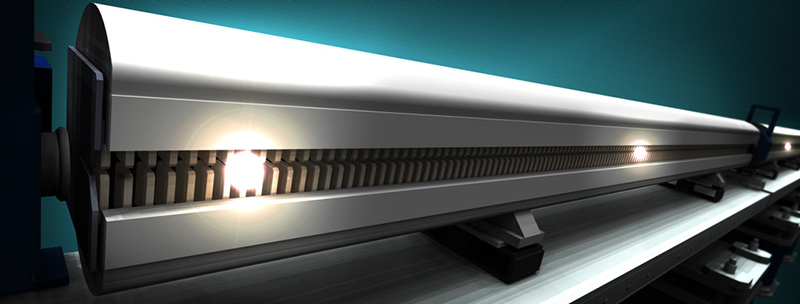X-ray Free Electron Laser (XFEL)

Electron pulse travelling through an undulator, emitting radiation. Image: Greg Stewart, SLAC
X-ray free-electron lasers (XFELs) are the first lightsources that are able to routinely generate coherent, ultra-brilliant, tunable laser pulses in the X-ray regime. With Angstrom (10-10 m) wavelength and simultaneoulsy femtosecond (10-15 s) pulse durations their allow for the first time to resolve the structure and dynamics of matter on the atomic scale. Furthermore, due to their highly intense pulses, they will push the frontiers in numerous scientific fields, such as physics, chemistry, materials science, biology, and the life science. In contrast to conventional lasers where the amplification is achieved by transitions of excited electrons in bound atomic or molecular states, FELs use a beam of relativistic ”free” (unbound) electrons as gain medium.
These electrons are propagated through an alternating magnetic field (undulator), which forces them onto a sinusoidal trajectory. Due to the transverse acceleration, the relativistic electrons emit X-ray radiation in form of synchrotron radiation into a narrow forward cone. In contrast to an undulator source (which is based on a similar setup), FELs are able to emit coherent (and thus significantly more intense) radiation. The coherence in FELs is caused by the feedback of the emitted radiation onto the electron beam, a process called ”SASE” (self-amplified spontaneous emission). Since it is extremely difficult to build mirrors for X-ray wavelengths, FELs have to get full amplification in a single pass.

The figure shows the electron pulse oscillating in the undulator and emitting synchrotron radiation. As the electron processes along the undulator (left to right), the emitted radiation becomes more intense and starts to act back onto the electrons by (depending on their position with respect to the lightwave) accelerating and decelerating a fraction of them. Due to this interaction, the electrons arrange themselves in so called "microbunches": sheets of electrons that are thinner than the wavelength of the emitted radiation. This results in the emission of coherent, intense radiation. Figure adapted from a figure by Greg Stewart, SLAC
One of the main advantages of the coherent radiation is the significantly higher brilliance compared to spontaneous sources: the intensity of coherent emission scales quadratically with the number of electrons Ne, whereas the spontaneous radiation scales only linear with Ne. In order for radiation to be emitted coherently, it has to originate from electrons that are located at a distance smaller than wavelength of the emitted radiation. The electron pulse duration is typically longer than the wavelength for radiation in the X-ray range. However, coherent emission can nevertheless be achieved by “microbunching” where electrons are self-arranged by the FEL process into sufficiently small regions within the bunch through the SASE process mentioned above.